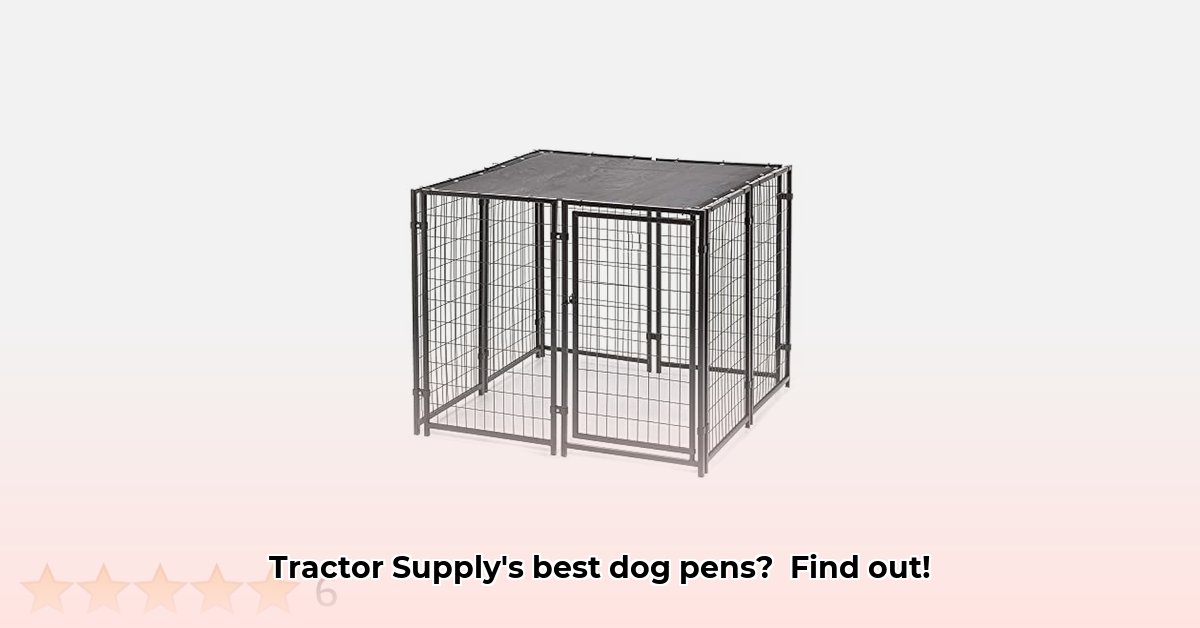
Dog Pen Tractor Supply: Making Smart Choices for Your Pup and the Planet
Finding the perfect dog pen from Tractor Supply shouldn't be a chore. It's an opportunity to make a smart choice for your furry friend and the planet. This guide explores how to select a dog pen that's both pet-friendly and environmentally responsible, combining practicality with sustainability.
Thinking Beyond the Basics: Sustainability in Dog Pen Selection
Buying a dog pen involves more than just a purchase; it's a decision with environmental consequences. A durable pen reduces waste by minimizing the need for replacements, saving resources and energy in the long run. Consider the entire lifecycle – from manufacturing to disposal – when making your selection. What materials were used? How sustainable are the manufacturing processes? What's the pen's end-of-life impact?
Material Matters: Choosing Eco-Friendly Materials
Examine the materials used. Recycled plastics or sustainably harvested wood are excellent choices. Steel, sourced responsibly (with minimal environmental harm and fair labor practices), is also a strong, durable option. Even wood, a natural material, can have negative environmental impacts if it isn't from responsibly managed forests.
Pen design matters too. A repairable pen extends its lifespan, reducing waste. A durable, longer-lasting pen, even if it costs more upfront, translates to lower lifetime environmental impact and cost savings over repeated replacements.
Size and Space: Finding the Perfect Fit (For Your Dog and the Environment)
Choose a pen appropriately sized for your dog. This prevents unnecessary material use while ensuring your dog has enough space. An appropriately sized pen also simplifies training and management, enhancing the overall experience for both pet and owner.
Durability and Longevity: A Key to Environmental Responsibility
Durability is paramount. A high-quality, long-lasting pen reduces the need for frequent replacements, minimizing waste and resource consumption. Look for features like reinforced corners and weather-resistant materials that suggest longevity.
Beyond the Basics: Extra Features and Considerations
Portability contributes to sustainability. A foldable or collapsible pen offers storage and transport advantages, reducing the need for multiple pens. Features like shade coverings or integrated water bowls, while not intrinsically sustainable, can enhance your pet's comfort and potentially reduce the need for separate items.
Your Step-by-Step Guide to Choosing a Sustainable Dog Pen
Follow these steps for a responsible purchase:
- Assess Needs: Determine your dog's size, available space, budget, and activity level. This helps refine your options.
- Check Tractor Supply's Inventory: Browse Tractor Supply's online or in-store catalog to compare prices, features, and materials.
- Research Materials: Investigate the materials’ origins and sustainability certifications.
- Compare Designs: Prioritize features like portability, durability, ease of cleaning, and repairability.
- Read Reviews: Gain insights into durability and user satisfaction from other pet owners.
- Make Your Choice: Select the pen that best meets your dog's needs and your environmental values.
Weighing the Pros and Cons: Sustainable Dog Pen Options at a Glance
| Feature | Pros | Cons |
|---|---|---|
| Durable Materials | Longer lifespan, less frequent replacement, reduced waste | Often a higher upfront cost |
| Recycled Materials | Environmentally friendly, reduces reliance on virgin resources | Might have slightly lower strength than some new materials in some cases |
| Portable Designs | Convenient storage and transport, less material used overall | Might be slightly less sturdy than stationary pens |
| Ethically Sourced | Supports responsible practices, better for the planet | Requires extra research to verify sourcing claims |
Remember, choosing a sustainable dog pen benefits both your dog and the environment. By making conscious choices, you contribute to a more sustainable future. Continue to explore sustainable products for a lasting positive impact.
How to Reduce Energy Consumption in Vertical Farming Systems
Key Takeaways:
- Vertical farming, while offering many benefits, is often energy-intensive.
- Employing energy-efficient technologies and strategies is key to its sustainability.
- A holistic approach, from location to resource management, minimizes energy use.
- Continuous innovation and collaboration are essential for the future of vertical farming.
Lighting: Optimizing Energy Use
Lighting is a major energy consumer in vertical farms. High-efficiency LEDs are a superior alternative to traditional HPS lamps, consuming significantly less energy while providing customizable light spectrums for optimal plant growth. While the initial investment in LEDs is higher, long-term savings outweigh this cost and contribute to environmental sustainability.
Climate Control: Balancing Energy Efficiency and Plant Needs
Climate control (HVAC) systems are also energy-intensive. Improving insulation minimizes heat loss, and strategic farm location can leverage natural ventilation. Heat recovery systems, which reuse waste heat, also greatly reduce energy consumption. Careful system design is essential.
Renewable Energy Integration: Harnessing Sustainable Power Sources
Integrating renewable energy sources like solar and wind power reduces reliance on non-renewable energy. Solar panels can substantially reduce electricity bills, but location-specific sun exposure and wind patterns must be accounted for in the planning phase.
Water Management & Resource Recycling: Optimizing Resource Use
Efficient water management is crucial. Implementing efficient irrigation systems, rainwater harvesting, and nutrient film technique (NFT) reduces water needs, saving energy used in pumping and heating/cooling. Recycling water and nutrients further minimizes energy demands, creating a closed-loop system.
AI-Driven Optimization & Precision Agriculture: Leveraging Technology
AI and machine learning optimize lighting, climate control, and irrigation based on real-time data, improving yield and reducing waste. It’s akin to having a highly efficient plant manager working continuously.
Location Selection: Considering Environmental Factors
Farm location significantly affects energy consumption. A climate-controlled facility in a cold climate will need more energy for heating than one in a milder area. Choosing a suitable location is an important aspect of reducing energy consumption.